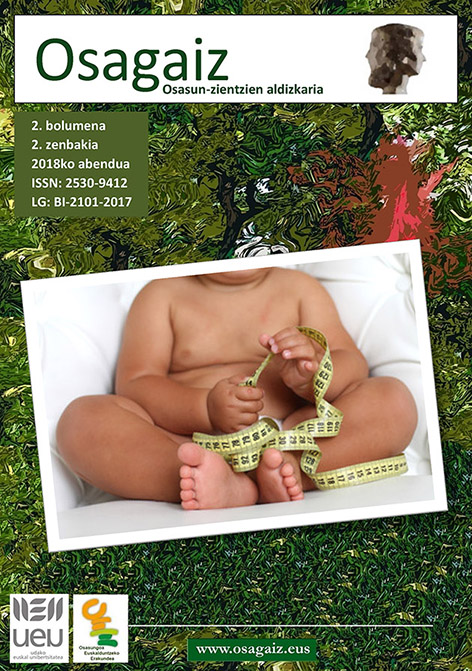Laburpena
kerketa honen helburua Gipuzkoako umeen pisuaren joera jaiotzetik 7 urtetara bitartean aztertzea zen, gurasoen ezaugarri soziodemografikoen eta antropometrikoen eragina aztertuz. INMA ikerketa multizentriko prospektiboko Gipuzkoako 450 ama-haur bikotek osatu zuten lagina. Jaiotzean, 1., 4. eta 7. urteetan neurtutako gorputz-masaren indizean (GMI) oinarrituz, jaiotzean ≥ 90eko pertzentilean eta gainerako adinetan ≥ 85eko pertzentilean izatea gehiegizko pisua (GP) bezala definitu zen, gainpisua eta obesitatea barne hartuz. Umearen eta gurasoen aldagai antropometrikoak, edoskitze mota, 4. urtean egindako elikagai-inkesta, gurasoen tabako-kontsumoa haurdunaldi garaian eta aldagai sozioekonomikoak aztertu ziren. Erregresio logistikoaren bitartez, aldagai bakoitzaren eragin zuzena ikertu zen. Jaiotzean umeen % 11k, 1. urtean % 49k, 4. Urtean %36k eta 7. urtean % 38k GPa zuten. Jaiotzean haurdunaldi-adinerako handia izatea eta lehen urtean pisu-hazkundea azkarra edukitzea ondorengo urteetako GParekin lotzen ziren. Neskek 4. eta 7. urteetan mutilek baino GP-arrisku handiagoa zuten. Edoskitzeak ez zuen GParekin lotura esanguratsurik adierazi. GPa 4. urtean proteinen eta karbohidratoen eta 7. urtean karbohidratoen eta gantz aseen zein poliasegabeen kontsumoarekin areagotzen zen. Paritateak jaiotzako GPa areagotzen zuen. Gurasoen GMIa umeen GParekin lotzen zen adin guztietan. Aitaren ikasketa-maila baxua jaiotzako GParekin eta ama atzerritarra izatea umeen 4. urteko GParekin erlazionatzen ziren. Aita erretzaileen umeek GPa edukitzeko arrisku handiagoa zuten 4. eta 7. urteetan, baina amaren tabako-kontsumoak ez zuen arriskua areagotzen. Lan honetan jaiotza eta 7 urte bitarteko GParen prebalentzia oso altua dela aurkitu da. Osasun-arazo garrantzitsu horri aurre egiteko neurri eraginkorrak hartu beharko lirateke, eta neurri horiek maila sozial guztietara iristen direla egiaztatu, maila sozial baxuetan arazo hau larriagoa baita.

